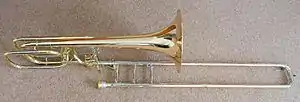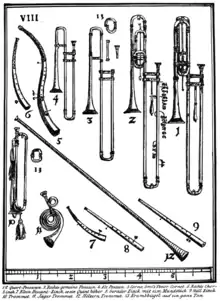Bass trombone
The bass trombone is the bass instrument in the trombone family of brass instruments. Modern instruments are pitched in the same B♭ as the tenor trombone but with a larger bore, bell and mouthpiece to facilitate low register playing, and usually two valves to fill in the missing range immediately above the pedal notes.
 Bass trombone with two valves in F and D | |
| Brass instrument | |
|---|---|
| Classification | |
| Hornbostel–Sachs classification | 423.22 (Sliding aerophone sounded by lip vibration) |
| Developed | Late 16th century |
| Playing range | |
 | |
| Related instruments | |
History

The earliest bass trombones were the bass sackbuts, usually pitched in G, F, or E♭ below the B♭ tenor. They had a smaller bore and less flared bell than modern instruments, and a longer slide with an attached handle to allow slide positions otherwise beyond the reach of a fully outstretched arm. The earliest known surviving specimen is an F instrument built in Germany in 1593.[1] This instrument matches descriptions and illustrations by Praetorius from his 1614–20 Syntagma Musicum.[2]: 18–19 These bass sackbuts were sometimes called terz-posaun, quart-posaun, and quint-posaun (Old German, lit. 'third' or 'fourth' or 'fifth trombone', referring to intervals below B♭), though sometimes quartposaune was used generally to refer to any of these.[3] The octav-posaun in B♭ refers to a very large and unwieldy predecessor of the contrabass trombone, a full octave below the tenor.[4]
Bass sackbuts were used in Europe during the Renaissance and early Baroque periods. By the 18th century the F and E♭ bass trombones were used in Germany, Austria and Sweden, and the E♭ bass trombone in France.
The "tenorbass" trombone
In 1839 Sattler invented the quartventil (lit. 'fourth valve'), a valve attachment for a B♭ tenor trombone to lower the instrument a fourth into F.[5]: 196 Initially intended to extend the range of the tenor trombone, it was adopted by bass trombone players particularly in Germany, where it was known as a tenorbaßposaune (lit. 'tenor bass trombone'). These instruments in B♭/F gradually replaced the larger bass trombones in F and E♭ over the course of the 19th and early 20th centuries.[6]
The bass trombone in Britain

The bass trombone in G enjoyed a period of extended popularity in France and Britain from the second half of the nineteenth century.[5]: 252 From the early twentieth century they were also built with a rotary valve attachment lowering the instrument into D or C, and used in British orchestras until the 1950s.[2]: 61 It lingered on in some parts of Britain and former British colonies into the 1980s, particularly in brass bands and period instrument orchestras.[7]
Construction
The modern bass trombone uses the same 9 feet (2.7 m) length of tubing as the tenor trombone, but with a wider bore, a larger bell, and a larger mouthpiece which facilitate playing in the low register.[5]: 196 Typical specifications are a bore size of 0.562 inches (14.3 mm) in the slide with a bell from 9 to 10+1⁄2 inches (23 to 27 cm) in diameter.[6]: 64
Dependent and independent valves

The bass trombone has one or (more typically) two valves that lower the pitch of the instrument when engaged, to facilitate the register between the B♭1 pedal in first position and the E2 second partial in seventh.[5]: 29 The first valve lowers the key of the instrument a fourth to F. The second (when engaged with the first) will lower the instrument to E♭ or (more commonly) D.[5]: 182
The second valve can be configured in one of two ways, referred to as either "dependent" or "independent" (sometimes also called "in-line"). In a dependent system, the second valve is fitted to the tubing of the first valve, and can only be engaged in combination with the first.[2]: 43–44 In an independent system, the second valve is fitted to the main tubing next to the first valve, and can be used independently. The second independent valve typically lowers the instrument to G or (more commonly) G♭, and when engaged in tandem with the first valve will result in lowering the instrument to E♭ or D, respectively.[2]: 73
Single valve instruments
The low B1 note immediately above the pedal range is unobtainable on a standard trombone slide with a single valve in F.[5]: 197 Bass trombones from the 19th- and early 20th-century were sometimes made with a valve attachment in E rather than F, or with an alternative tuning slide to lower the pitch to E♭. Today, single valve bass trombones have a tuning slide on the valve section that is long enough to enable access to the low B1 by lowering the pitch from F to E.[6]: 61
Range
The range of the modern bass trombone is fully chromatic from the lowest fundamental with the valve attachment tubing deployed. A bass trombone with the second valve in G♭ is capable of playing from a B♭0 (or even A0 with valve slides extended), up to C5. Many professionals can extend the range even higher, though such demands may be taxing to the player and/or unreliable. Older or more conservative compositions often shy away from extremes, and will infrequently stray above a G4 or below a B♭1. Contemporary orchestral and solo classical pieces, as well as modern jazz arrangements, will often further exploit the wide tonal range of the bass trombone.
Repertoire
There is usually one bass trombone in a standard symphony orchestra performing works in the Romantic period or later. It is also seen in military bands, brass bands, jazz bands, wind ensembles, and a variety of brass groups; the bass trombone is usually played by the third trombonist in a symphony orchestra trombone section, the first two parts usually being played by tenor trombones. In jazz, the most notable uses of the bass trombone are in two of pianist Herbie Hancock's recordings, Speak Like a Child (1968) and The Prisoner (1969), which employed the instrument for purely voicing purposes.
Images
 Bass trombone in F
Bass trombone in F Bass trombone in E♭
Bass trombone in E♭ Single valve bass trombone in B♭/F
Single valve bass trombone in B♭/F
See also
References
- "Bastrombone, Pierre Colbert, 1593". Rijksmuseum (in Dutch). Retrieved 2022-05-02.
- Douglas Yeo (2021). An Illustrated Dictionary for the Modern Trombone, Tuba, and Euphonium Player. Dictionaries for the Modern Musician. Illustrator: Lennie Peterson. Lanham: Rowman & Littlefield. ISBN 978-1-53815-966-8. LCCN 2021020757. OCLC 1249799159. OL 34132790M. Wikidata Q111040546.
- Baines, Anthony C.; Herbert, Trevor (2001). "Quartposaune". Grove Music Online (8th ed.). Oxford University Press. doi:10.1093/gmo/9781561592630.article.22657.
- Clifford Bevan (2000). The Tuba Family (2nd ed.). Winchester, Hampshire: Piccolo Press. ISBN 1-872203-30-2. OCLC 993463927. OL 19533420M. Wikidata Q111040769.
- Trevor Herbert (2006). The Trombone. New Haven: Yale University Press. ISBN 978-0-300235-75-3. OCLC 1007305405. OL 30593699M. Wikidata Q111039091.
- David M. Guion (2010). A History of the Trombone. Toronto: Scarecrow Press. ISBN 978-0-81087-445-9. OCLC 725775517. OL 24019524M. Wikidata Q111039945.
- Dixon, Gavin (2010). "Farewell to the Kidshifter: The Decline of the G Bass Trombone in the UK 1950–1980". Historic Brass Society Journal. 22: 75–89. doi:10.2153/0120100011004.